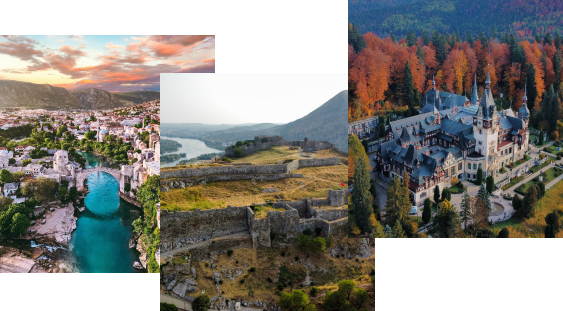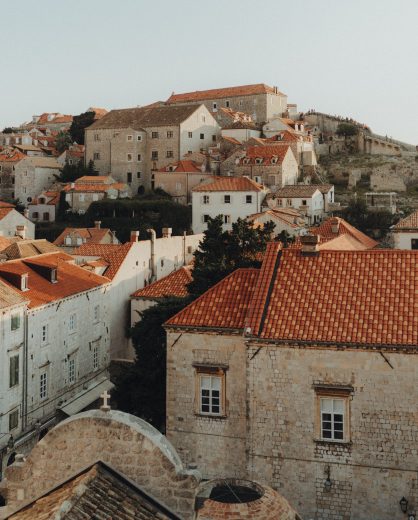Balkans Tour Packages







The Balkan region covers a vast area and a wide variety of cultures, civilisations, cuisines and landscapes. Named for the Balkan mountains and once regarded as a peninsula, it’s a region whose constituent countries seems to change depending on who you ask. For our purposes, and because we cover all the countries in even the most expansive definition, we’re including
Albania, Bosnia and Herzegovina, Bulgaria, Croatia, Greece, Kosovo, Montenegro, North Macedonia, Romania, Serbia and Slovenia.
Although every Balkans tour package we create is unique, there are some popular routes and itineraries that we are asked for frequently. Our sample itineraries provide some ideas for you to consider as a basis for your own private tour combining two or more of the Balkan countries, sometimes branching out into neighboring countries in Central and Eastern Europe.
For each of these itineraries you can get a rough idea of the price using the Price Guide function. We cover many more destinations in these three countries than those listed here, and our expert trip planners will work with you to incorporate any places in the Balkans you want to go.
* Starting price is per person, based on double occupancy in 3 star accommodation, in the most affordable month an itinerary is offered. Airfare to Europe is not included.
Click on your choice of itinerary, select number of travelers in your party, month of travel, and desired star level of accommodation to get an approximate price. Submit the enquiry form with any additional details and we can start planning your customized trip.
Average of our Guest's Ratings of our Central Europe Tour Packages. Based on 139 reviews
Our Balkans vacations provide a hassle-free way to see these captivating countries. We take care of all the details, all you have to worry about is enjoying the one-of-a-kind experiences that will make this the vacation of a lifetime. Below you’ll find the most recent three reviews and testimonials from guests who have visited the Balkan region with our help recently.
Jayway planning and customization is excellent. Their use of technology makes trip planning and communications easy. Having a trip coordinator , easy to get to gives clients a sense of personalization that I rarely experienced
Visited : Hungary, Austria, Czech Republic
Itinerary : Budapest, Vienna, Salzburg, Prague
Rating :
Our JayWay Travel tour exceeded our expectations. We felt “well taken care of” in every city we visited. Everything was outstanding, as we not only enjoyed, but also learned a lot.
Visited : Czech Republic, Austria, Hungary
Itinerary : Prague, Vienna, Budapest
Rating :
Personalized and detail oriented travel agency. Professional and great value for all the attention to detail.
Visited : Czech Republic, Austria
Itinerary : Prague, Cesky Krumlov, Brno, Vienna
Rating :

With countries as diverse as Greece, Romania, Croatia and Slovenia, a tour of the Balkans can provide all kinds of experience. We advise against trying to cover too many countries in one trip – there’s more than enough for a lifetime of travels in the Balkans after all! A private tour of the Balkans offers the perfect opportunity to mix some city time with a relaxing island stay or a refreshing spell in unspoilt countryside.
If you’ve never visited the Balkans before, we suggest starting with a country like Croatia and combining that with one of the neighboring countries, such as Montenegro or Bosnia and Herzegovina to experience the variety and contrast that this region provides.
With competing influences and a place in history that stretches back to the ancient Greeks and beyond, there’s no shortage of important archeological sites throughout the Balkans. Roman emperors palaces, imposing fortresses, ancient Greek or Roman theatres and amphitheatres are to be found in many Balkan countries.
Between Greece and Croatia’s islands there’s something for every tastes, from ever-popular Santorini to under-the-radar former naval stronghold Vis, two hours from Croatia’s mainland. Head inland for buzzy capital cities like Belgrade, Tirana or Bucharest. Enjoy active pursuits in outstanding countryside in Montenegro’s Durmitor National Park or get to know one of history’s darker characters in bucolic Transylvania, Romania’s heartland.
Our expert Balkans travel advisors and trip planners will work with you to create your dream vacation itinerary. You’ll stay at the very best hotels, apartments or villas. You choose how you want to spend your days, either enjoying day trips and city tours with our trusted partners or taking a day off to wander on your own. Before you arrive and during your trip our on-the-ground staff throughout the region are on hand by phone or email for any help you need. With our years of experience in arranging trips in the Balkans we’re perfectly placed to create the most memorable trip you’ve ever experienced.

Our Balkans vacations provide a hassle-free way to see these captivating countries. We take care of all the details, all you have to worry about is enjoying the one-of-a-kind experiences that will make this the vacation of a lifetime. Below you’ll find the most recent three reviews and testimonials from guests who have visited the Balkan region with our help recently.

Planning an amazing trip takes time. Our friendly travel advisors and experienced trip planners will listen to your needs and craft your personal dream itinerary. We will maximize your vacation time and enjoyment – we know the best way to get around and how to spend your hard-earned time off.

You’re in safe hands from the very beginning. Even before you arrive your dedicated tour manager in Europe will be in touch to help you prepare. When you arrive they’ll meet you and be available by phone, email and IM for the rest of your journey with us, for anything you need.

Travel can create memories that last a lifetime. You’ll return home with indelible recollections of beautiful sunsets, magical vistas, fascinating stories, and meals so delicious you’ll want to fly back every time you think of them. This is why we do what we do.
Most of our guests travel to Central Europe from the US by air, unless they are already traveling in a neighboring country. There are direct flights to many Central European capitals, including Berlin, Prague, Budapest, Warsaw and Vienna as well as to Munich in Germany and several Swiss cities. We usually recommend getting an “open jaw” ticket which has you flying in to the first city on your trip and out of the last. This will save time and usually cost less when you factor in the cost of returning to the first city on your itinerary. Although we don’t sell airfare, our travel advisors will help you pick out the best fare and routing.
Where should I start my tour of Central Europe?
With so many potential routes, it all depends on which cities you want to see on your custom tour. Our travel advisors and expert trip planners will help you decide when we prepare your initial itinerary. Any of our sample itineraries can also be taken in reverse.
Spring, early summer and early fall are the very best times of year to visit Central Europe if you’re visiting for a primarily cultural and historical interest trip. The weather is not dissimilar to that of New York. July and August can be very warm. Late fall and January through mid March are the low season. Hotel and flight prices are lower but there are fewer, or no, direct flights from the US to cities like Prague and Budapest at that time. The cities experience another busy period with Christmas markets visitors from late November until New Years.
It is very difficult to see all of Central Europe in one trip and many of our guests make several trips, sometimes revisiting favorite places mixed with new cities for them. With just a week we suggest no more than two big cities, such as Prague and Budapest or Vienna and maybe a smaller city in between. With ten days you could spend three nights in each of three cities. This gives you enough time to experience the city itself and take a day trip somewhere close by to get more of a sense for the country as a whole.
The most popular itinerary for a Central Europe tour is Prague, Vienna, and Budapest. Each of these three capital cities have unique characteristic. This route combines the postcard-perfect magic of Prague Castle and Charles Bridge, the Imperial grandeur of Vienna, and dreamy Budapest, with its thermal baths and Danube river views of the impressive parliament building from Fisherman’s Bastion.
Being in the middle of our map, there are plenty of possible extensions, if you have time. You could go further east, to Ukraine or head south to the Balkans, via Slovenia. A pairing we arrange often is Prague and Croatia, thanks to inexpensive direct flights between the two countries.
As most of the distances between cities are less than five hours by road or rail, we don’t recommend traveling by plane once you’ve arrived in Europe. Based on your preferences and budget we can include train or bus station transfers and tickets, or door-to-door private transfers in your travel package. One advantage of a private transfer over taking the train is the ability to make stops at places of interest along the way.
For a couple of reasons. Firstly there’s really no better description for the group of countries that are located in the geographical heart of Europe. Secondly, although some of these countries were ‘behind the iron curtain’ as Communist countries and satellite states of the Soviet Union, they have developed significantly in the three decades since gaining independence to the point of being indistinguishable from their western neighbors, especially in the capitals and major cities. Locals in the Czech Republic, Hungary, Poland and Slovakia feel, to a lesser or greater degree, insulted by the epithet ‘Eastern European’. While some tour companies include everything east of Germany in “Eastern Europe”, then stop when they reach Croatia or Hungary, we like to be a little more precise. We consider Eastern Europe to be countries genuinely in the east of the continent: Russia, Ukraine, Belarus and Moldova.
Although several of the countries in Central Europe have adopted the Euro, there are still several holdouts. Czech Republic, Hungary and Poland have retained their own currencies and Switzerland is not a member of the EU and therefore still uses the Swiss Franc.














